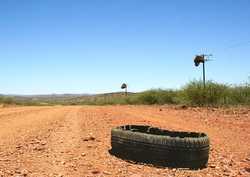
Tire blowouts usually occur without warning and can cause a total loss of control over the vehicle’s direction. What happens in the split seconds from blowout to complete stop can make all the difference between minor injuries and fatal consequences. Tire blowouts occur because of defective design, improper maintenance, or debris in the roadway. Because blowouts are often unpredictable, motorists should remain alert for the possibility of a blowout at all times when they are behind the wheel of a motor vehicle. Car accident lawyers suggest that drivers pay attention to the following:
The Sound of Failure
It is important to keep the volume of radios and conversations down at all times when driving so that drivers can hear the sound of the road beneath the wheels. When a tire blows out, it may sound like a boom, bang, or loud pop. This sound resonates throughout the vehicle. In the ensuing seconds, it is often possible to hear a hissing/whooshing sound as the air escapes from within the tire. This is followed by a flapping, flopping sound as the deflated rubber of the tire slaps against the asphalt or concrete. There may also be sparks as the rim grinds against the asphalt, concrete, or gravel of the road surface.
How a Blowout Feels
A tire blowout will slow the vehicle down immediately. As speed decreases, the vehicle will start to pull to the side where the tire has blown. If a front tire is blown, the driver may have significant difficulty steering the vehicle. If it is a rear tire that blows, the vehicle may feel less responsive and the vehicle may start to “fishtail” as the driver struggles to control the direction of the car.
Seconds Towards Safety
What happens in the seconds immediately following a blowout is critical in protecting drivers and passengers from injury. Drivers must remain calm and calculate their decisions so they make the right choice when the moment matters. Motorists should maintain a firm grip on the wheel and should resist the temptation to slam down on the brakes. This is especially important if the vehicle is traveling at high speed. If the car is rapidly decelerating, it can be advisable to apply the gas to help regain control over the vehicle. Once control is regained and the vehicle has slowed to below 30 mph, drivers should allow the vehicle to gradually decelerate.
When a tire blows, gradual deceleration can help you maintain control over the vehicle. Conversely, a sudden slowdown can cause the wheels to pull too sharply to one side and cause the vehicle to veer off the road or flip over.
As the vehicle slows, motorists should immediately identify the nearest safe location to pull off the roadway. Drivers should keep their hands on the wheel and wait to turn on their emergency flashers until the vehicle has come to a complete stop. However, if there is a passenger in the front seat and the vehicle has flasher controls on the center console, the passenger can activate these lights at any time.
Following the Stop
Drivers and passengers should make sure they do not exit the vehicle in an unsafe area where traffic, weather conditions, etc. could jeopardize their safety. As soon as it is safe to exit the vehicle, motorists should position reflective cones or triangles on the roadway from within their emergency roadside kit. If possible, drivers should replace their blown tire with the spare. If this is not possible, drivers should call for assistance and wait in the vehicle until roadside assistance arrives.
Preventing the Next Blowout
Tires should be routinely checked for proper inflation. Drivers should check their tires at least once per month to ensure that they are not over or under-inflated. Further, if air loss is regular and recurring, tires should be repaired by a professional maintenance team.
Drivers should also inspect their tires for proper tread and signs of uneven wear. If the tire is wearing unevenly, the vehicle may require alignment or adjustment of the suspension system. If the vehicle is equipped with tire inflation indicators, motorists not ignore these warnings. They should pull over to inspect the vehicle at the soonest and safest opportunity.
It is also crucial to maintain a cautious eye on the road ahead. Motorists should stay alert for obstructions and changes in road conditions that could cause a blowout. In particular, motorists should avoid potholes, rocks, and other debris that can puncture the tire.
Finally, everyone in the vehicle should always wear their seat belt. This can help protect vehicle occupants from injuries or sudden ejection from the vehicle should it roll.

